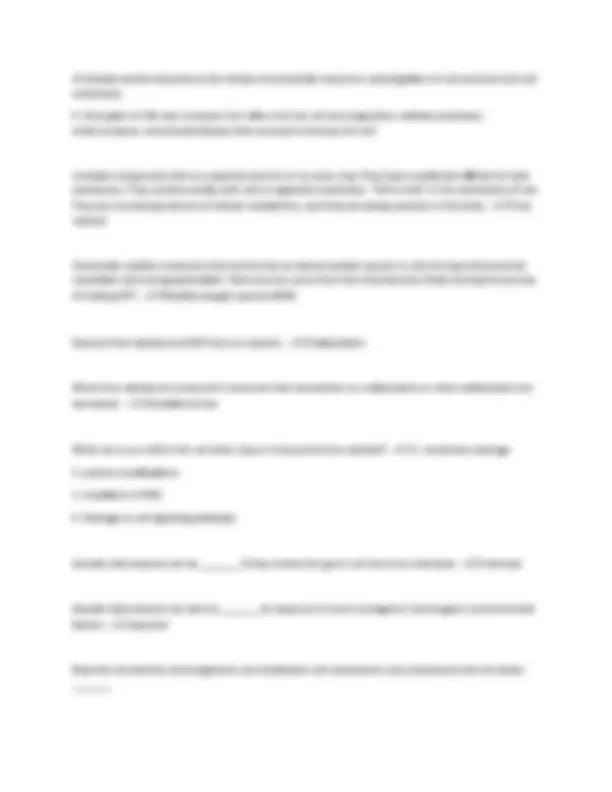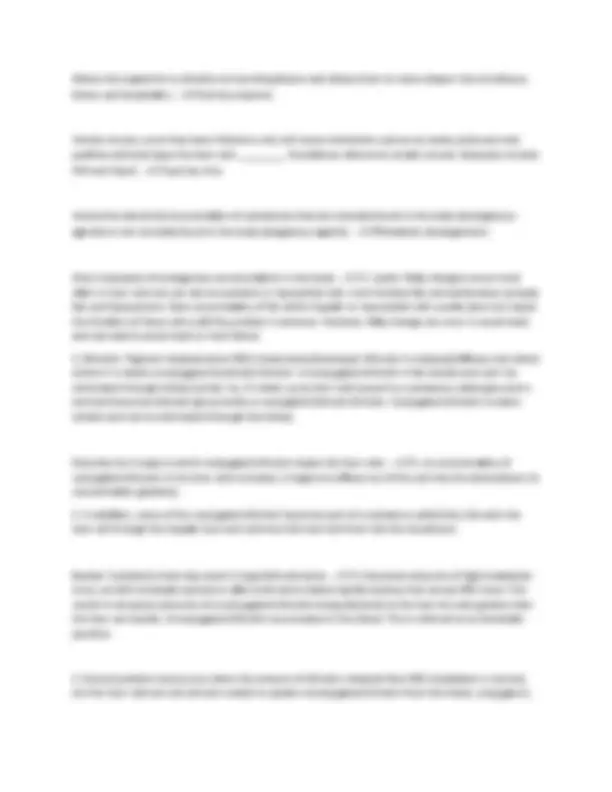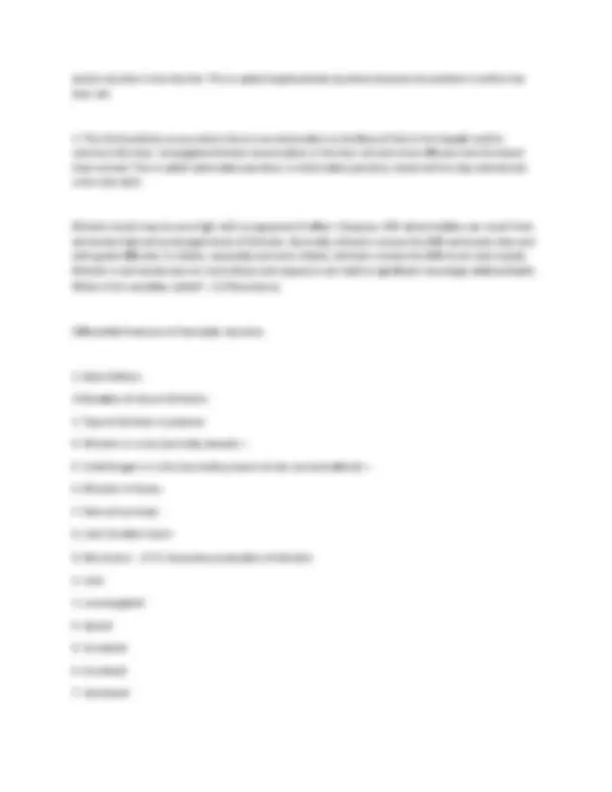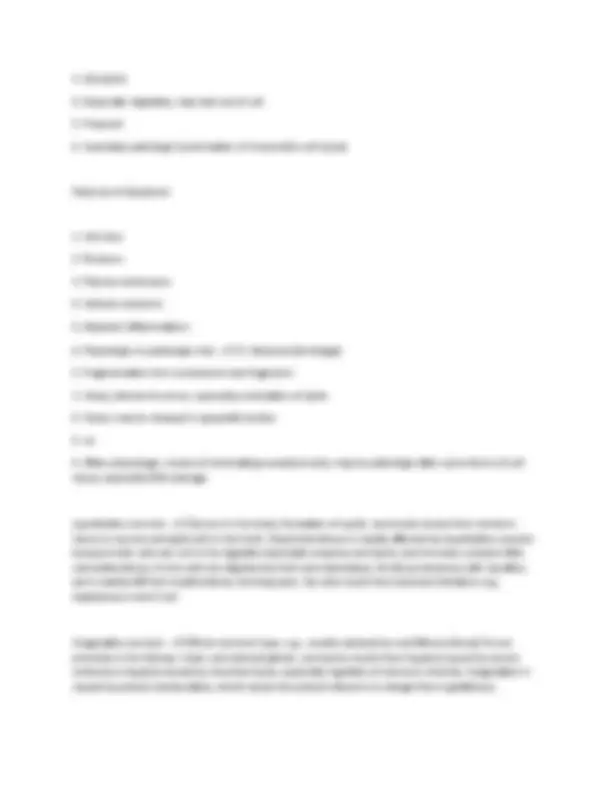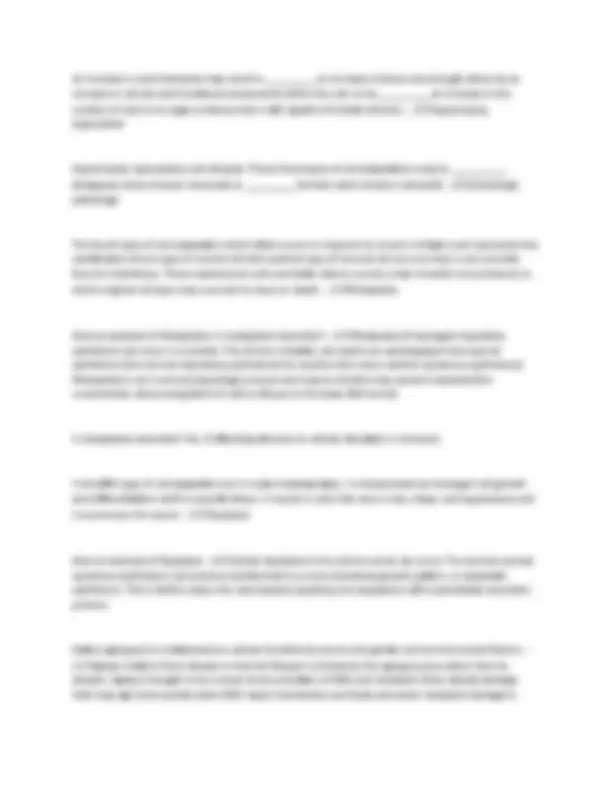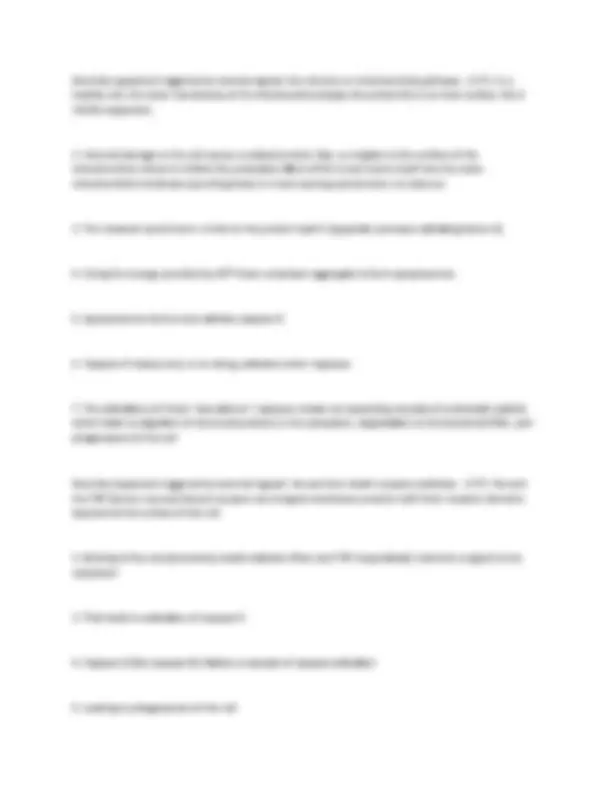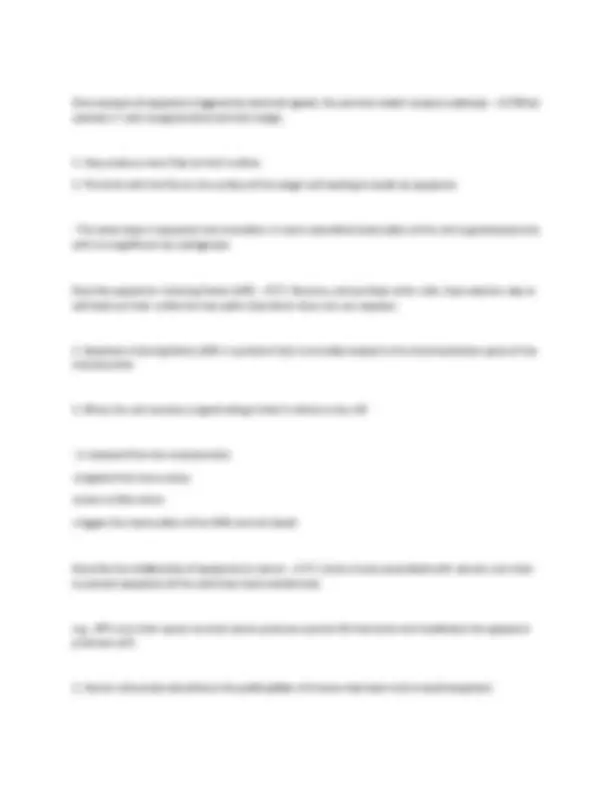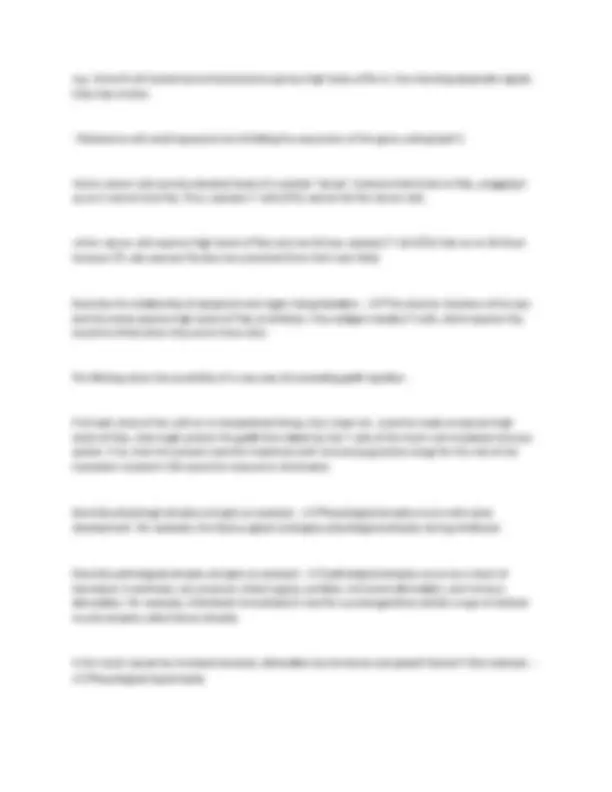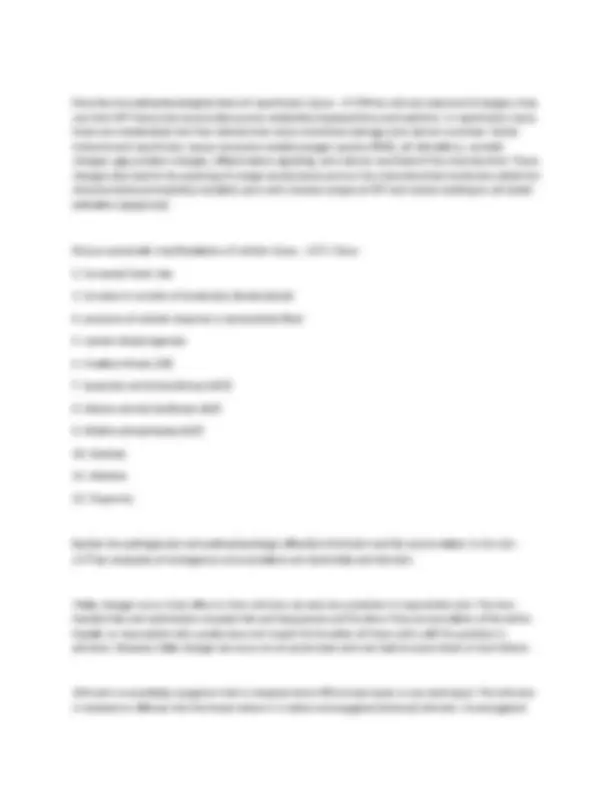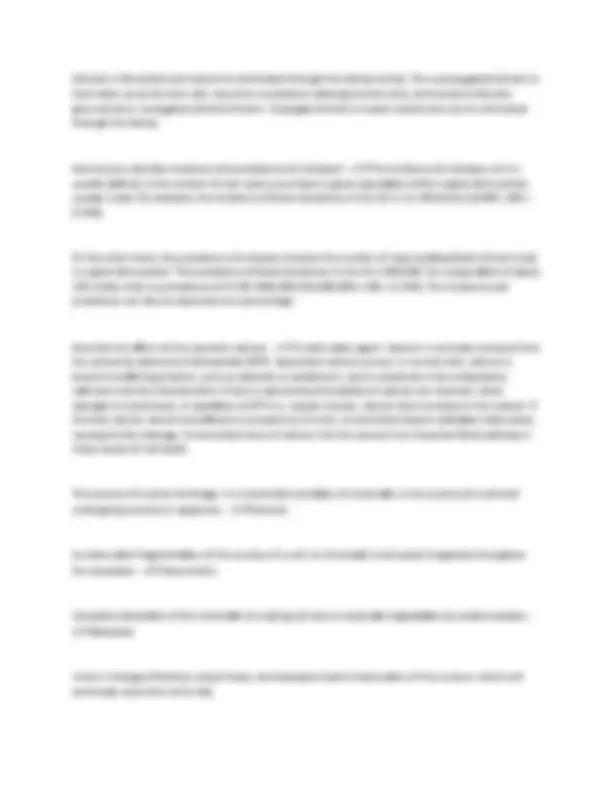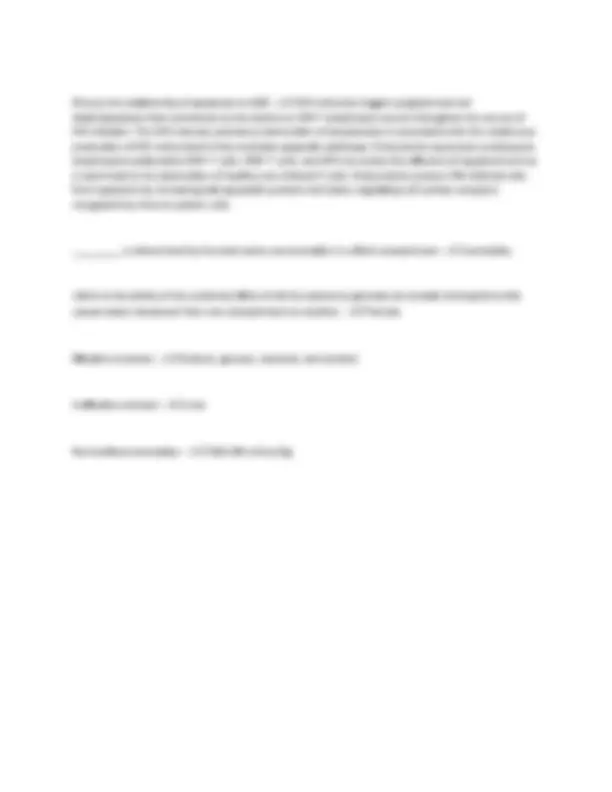Download Cell Injury and Death: Pathogenesis, Mechanisms, and Outcomes and more Exams Pathophysiology in PDF only on Docsity!
Pathophysiology NSG 533 Exam 1 Questions
with 100% Correct Answers | Latest Version 2024
| Verified
What are the five essential components of pathophysiology? - ✔✔
- Etiology (Causative mechanisms)
- Epidemiology (risk factors and distribution in populations)
- Pathogenesis (disease mechanism)
- clinical manifestations (signs, symptoms and diagnostic criteria)
- Outcomes (cure, remission, chronicity, or death) The "why" of disease- what is the reason for it- what caused it to happen? May be simple/complex. - ✔✔etiology Looks at the pattern of disease among groups or aggregates or populations. This component of disease represents the relationship between numerous population characteristics (e.g. age, ethnicity, socioeconomic status, geographic location) and the incidence and prevalence of disease. - ✔✔Epidemiology Involves the sequence of events that occurs between the stimulus event(s) and the manifestations of the disease. - ✔✔pathogenesis Tell an individual and their health care provider that something is wrong. e.g. Signs and symptoms - ✔✔Clinical manifestations Are relatively easy to understand if you review their definitions (cure, remission, chronicity, or death) - ✔✔Outcomes What are the 4 common mechanisms that characterize all cell injury and death? Give 2 examples of each. - ✔✔1. ATP depletion- Ischemia and Anemia
- Oxygen and oxygen-derived free radicals- Chemical and radiation injury, ischemia reperfusion injury, microbial killing by phagocytes, and cellular aging
- intracellular calcium and loss of calcium steady state- Ischemia and certain chemicals
- Defects in membrane permeability- Certain medications that can lead to liver or kidney damage The disease mechanism that is the basis of much of the disease today- and most of the cases involve hypoxia. Refers to the inability of the cell to produce adequate energy to fuel normal activities of that particular cell type (cell membrane pumps and protein synthesis) and function. - ✔✔ATP depletion A very inefficient method of ATP production (yields 2 ATP) - ✔✔glycolysis Is a very efficient method of ATP production (yields 36 ATP) - ✔✔Oxidative Phosphorylation What is the most common method of impairing oxygen and ATP production? - ✔✔hypoxia Can lead to irreversible cell injury directly through impairment of energy production in the cell. - ✔✔Ischemia What are the cellular events that occur with ischemia-induced- hypoxic injury? - ✔✔1. The amount of ATP production within the mitochondria declines
- The drop in ATP causes NA-K- ATPase pump on CM to fail. Which then leads to increase in NA+,H2O, and Ca+ in cell and decrease in K+ in cell.
- Increase in water in cell causes cell and it's organelles to swell.
- When RER swell it's ribosomes fall off and protein synthesis stops.
- ATP production through phosphorylation declines and glycolysis (anaerobic metabolism) increases. When glycolysis increases in the cell glycogen stores are depleted.
- Glycolysis also produces lactic acid as by-product. Glycolysis also = intracellular pH decline ( the cell functions within narrow range of pH and even slight drop can incapacitate the cell).
- Drop in pH causes clumping of nuclear material called pyknosis. Leads to fragmentation of the nuclear material (karyorrhexis) and then to dissolution of nuclear membrane (karyolysis). Decline in pH= rupture
Allows the organisms to dissolve surrounding tissues and allows them to move deeper into the tissues, blood, and lymphatics. - ✔✔lysis by enzymes Certain viruses, once they have infected a cell, will cause membrane rupture as newly produced viral particles (virions) leave the host cell= ________. Sometimes referred to as lytic viruses. Examples include HIV and Hep B. - ✔✔Lysis by virus Involve the abnormal accumulation of substances that are normally found in the body (endogenous agents) or not normally found in the body (exogenous agents). - ✔✔Metabolic derangements Give 2 examples of endogenous accumulations in the body. - ✔✔1. Lipids: Fatty changes occurs most often in liver cells but can also be problem in myocardial cells. Liver handles fats and synthesizes complex fats and lipoproteins. Slow accumulation of fat within hepatic or myocardial cells usually does not impair the function of those cells until the problem is extreme. However, fatty change can occur in acute basis and can lead to acute heart or liver failure.
- Bilirubin: Pigment released when RBCs break down/destroyed. Bilirubin is released/diffuses into blood where it is called unconjugated (indirect) bilirubin. Unconjugated bilirubin is fat-soluble and can't be eliminated through kidney (urine). So, it's taken up by liver cells bound to a substance called glucuronic acid and becomes bilirubin glucuronide or conjugated (direct) bilirubin. Conjugated bilirubin is water- soluble and can be eliminated through the kidney. Describe the 2 ways in which conjugated bilirubin leaves the liver cells. - ✔✔1. As concentration of conjugated bilirubin in the liver cells increases, it begins to diffuse out of the cell into the blood (down its concentration gradient).
- In addition, some of the conjugated bilirubin becomes part of a substance called bile; bile exits the liver cell through the hepatic duct and common bile duct and then into the duodenum. Explain 3 problems that may result in hyperbilirubinemia. - ✔✔1. Excessive amounts of Hgb breakdown occur, as with hemolytic anemia or after birth when babies rapidly destroy their excess RBC mass. This results in excessive amounts of unconjugated bilirubin being delivered to the liver at a rate greater than the liver can handle. Unconjugated bilirubin accumulates in the blood. This is referred to as hemolytic jaundice.
- Second problem area occurs when the amount of bilirubin released from RBC breakdown is normal, but the liver cells are sick and are unable to uptake unconjugated bilirubin from the blood, conjugate it,
and/or excrete it into the bile. This is called hepatocellular jaundice because the problem is within the liver cell.
- The third problem occurs when there is an obstruction to the flow of bile in the hepatic and/or common bile duct. Conjugated bilirubin accumulates in the liver cell and more diffuses into the blood than normal. This is called obstructive jaundice. In obstructive jaundice, stools will be clay colored and urine very dark. Bilirubin levels may be very high with no apparent ill effect. However, CNS abnormalities can result from extremely high and prolonged levels of bilirubin. Normally, bilirubin crosses the BBB extremely slow and with great difficulty. In infants, especially pre-term infants, bilirubin crosses the BBB much more easily. Bilirubin is extremely toxic to nerve tissue and exposure can lead to significant neurologic deficits/death. What is this condition called? - ✔✔Kernicterus Differential Features of Hemolytic Jaundice
- Basic Defect= 2.Elevation of serum bilirubin=
- Type of bilirubin in plasma=
- Bilirubin in urine (normally absent) =
- Urobilinogen in urine (normally present at low concentrations) =
- Bilirubin in feces=
- Red cell survival=
- Liver function tests=
- Bile ducts= - ✔✔1. Excessive production of bilirubin
- mild
- unconjugated
- absent
- increased
- increased
- decreased
- Urobilinogen in urine (normally present at low concentrations) =
- Bilirubin in feces=
- Red cell survival=
- Liver function tests=
- Bile ducts= - ✔✔1. Obstruction of bile ducts
- severe
- conjugated
- present
- decreased (absent)
- decreased
- normal
- variable
- obstructed disorganized sequence of events that that stimulate the inflammatory process and signals us that cell death is occurring. - ✔✔Cell necrosis Quiet, organized, programmed process resulting in elimination of individual cells. May be physiologic or pathologic. Not associated with inflammation. - ✔✔Apoptosis (type I programmed cell death) Features of Necrosis
- Cell size=
- Nucleus=
- Plasma membrane=
- Cellular contents=
- Adjacent inflammation=
- Physiologic or pathologic role - ✔✔1. enlarged (swelling)
- pyknosis-> karyorrhexis-> karyolysis
- disrupted
- Enzymatic digestion; may leak out of cell
- Frequent
- Invariably pathologic (culmination of irreversible cell injury) Features of Apoptosis
- Cell size=
- Nucleus=
- Plasma membrane=
- Cellular contents=
- Adjacent inflammation=
- Physiologic or pathologic role - ✔✔1. Reduced (shrinkage)
- Fragmentation into nucleosome-size fragments
- Intact; altered structure, especially orientation of lipids
- Intact; may be released in apoptotic bodies
- no
- Often physiologic, means of eliminating unwanted cells; may be pathologic after some forms of cell injury, especially DNA damage Liquefactive necrosis - ✔✔(occurs in the brain; formation of cysts): commonly results from ischemic injury to neurons and glial cells in the brain. Dead brain tissue is readily affected by liquefactive necrosis because brain cells are rich in the digestive hydrolytic enzymes and lipids, and the brain contains little connective tissue. As the cells are digested by their own hydrolases, the tissue becomes soft, liquefies, and is walled off from healthy tissue, forming cysts. Can also result from bacterial infections e.g., staphylococci and E.coli Coagulative necrosis - ✔✔(Most common type, e.g., usually replaced by scar/fibrous tissue) Occurs primarily in the kidneys, heart, and adrenal glands, commonly results from hypoxia caused by severe ischemia or hypoxia caused by chemical injury, especially ingestion of mercuric chloride. Coagulation is caused by protein denaturation, which causes the protein albumin to change from a gelatinous,
An increase in work demands may result in _________ an increase in tissue size brought about by an increase in cell size and functional components within the cell--or by _________ an increase in the number of cells in an organ or tissue that is still capable of mitotic division. - ✔✔Hypertrophy, hyperplasia Hypertrophy, hyperplasia, and atrophy- These three types of cell adaptations may be __________ (disappear when stressor removed) or _________ (remain when stressor removed) - ✔✔physiologic, pathologic The fourth type of cell adaptation which often occurs in response to chronic irritation and represents the substitution of one type of normal cell with another type of normal cell, but one that is not normally found in that tissue. These replacement cells are better able to survive under stressful circumstances in which original cell type may succumb to injury or death. - ✔✔Metaplasia Give an example of Metaplasia. Is metaplasia reversible? - ✔✔Metaplasia of laryngeal respiratory epithelium can occur in a smoker. The chronic irritation can lead to an exchanging of one type of epithelium (the normal respiratory epithelium) for another (the more resilient squamous epithelium). Metaplasia is not a normal physiologic process and may be the first step toward neoplasia (the uncontrolled, abnormal growth of cells or tissues in the body AKA tumor) Is metaplasia reversible? Yes, if offending stimulus to cellular alteration is removed. Is the fifth type of cell adaptation but is really maladaptation. Is characterized by deranged cell growth and differentiation within a specific tissue. It results in cells that vary in size, shape, and appearance and is a precursor for cancer. - ✔✔Dysplasia Give an example of Dysplasia - ✔✔Cellular dysplasia in the uterine cervix can occur. The normal cervical squamous epithelium can become transformed to a more disorderly growth pattern, or dysplastic epithelium. This is farther down the road toward neoplasia, but dysplasia is still a potentially reversible process. Define aging and its relationship to cellular function/structure and genetic and environmental factors. - ✔✔Aging is distinct from disease in that the lifespan is limited by the aging process rather than by disease. Aging is thought to be a result of accumulation of DNA and metabolic (free radical) damage. Cells may age more quickly when DNA repair mechanisms are faulty and when metabolic damage is
excessive because of reduced antioxidants. Aging is the progressive loss of tissues and organs over time. Possible causes of aging are genetic, epigenetic, inflammatory, oxidative, stress, and metabolic origins. Age related changes in body systems can generally be described as ____________. - ✔✔a decrease in functional reserve and a reduced ability to adapt to environmental changes. What is aging associated with? - ✔✔Inflammation, hypercoagulability, and immune changes. Diet is thought to play a major role in the development of age-related diseases. A clinical syndrome that describes someone vulnerable to falls, functional decline, disability, disease, and death. May involve oxidative stress, inflammation, malnutrition, physical inactivity, and muscle changes.
- ✔✔Frailty- Age related disease What are the two ways in which cells die? - ✔✔1. Killed by injurious agents
- Induced to commit suicide Describe a cell's death by injury and the series of changes they go through - ✔✔1. Mechanical damage
- Exposure to toxic chemicals Changes= 1. They swell
- Cell contents leak out leading to
- inflammation of surrounding tissues What happens to cells that are induced to commit suicide? - ✔✔1. Shrink
- develop bubble-like blebs on their surface
- Have chromatin (DNA and protein) in their nucleus degraded
- Have their mitochondria break down with the release of cytochrome c
- Break into small, membrane-wrapped, fragments
- release ATP and UTP (mammalian cells)
Describe apoptosis triggered by internal signals: the intrinsic or mitochondrial pathway - ✔✔1. In a healthy cell, the outer membranes of its mitochondria display the protein Bcl-2 on their surface. Bcl- 2 inhibits apoptosis.
- Internal damage to the cell causes a related protein, Bax, to migrate to the surface of the mitochondrion where it inhibits the protective effect of Bcl-2 and inserts itself into the outer mitochondrial membrane punching holes in it and causing cytochrome c to leak out
- The released cytochrome c binds to the protein Apaf-1 (apoptotic protease activating factor-1)
- Using the energy provided by ATP these complexes aggregate to form apoptosomes
- Apoptosomes bind to and activate caspase- 9
- Caspase-9 cleaves and, in so doing, activates other caspases.
- The activations of these "executioner" caspases creates an expanding cascade of proteolytic activity which leads to digestion of structural proteins in the cytoplasm, degradation of chromosomal DNA, and phagocytosis of the cell Describe Apoptosis triggered by external signals: the extrinsic death receptor pathway - ✔✔1. Fas and the TNF (tumor necrosis factor) receptor are integral membrane proteins with their receptor domains exposed at the surface of the cell
- Binding of the complementary death activator (FasL and TNF respectively) transmits a signal to the cytoplasm
- That leads to activation of caspase 8
- Caspase 8 (like caspase 9) initiates a cascade of caspase activation
- Leading to phagocytosis of the cell
Give example of apoptosis triggered by external signals: the extrinsic death receptor pathway - ✔✔When cytotoxic T cells recognize (bind to) their target,
- they produce more FasL at their surface
- This bind with the Fas on the surface of the target cell leading to death by apoptosis
- The early steps in apoptosis are reversible- In some cases final destruction of the cell is guaranteed only with its engulfment by a phagocyte. Describe apoptosis- Inducing Factor (AIF) - ✔✔1. Neurons, and perhaps other cells, have another way to self-destruct that- unlike the two paths described- does not use caspases
- Apoptosis inducing factor (AIF) is a protein that is normally located in the intermembrane space of the mitochondria
- When the cell receives a signal telling it that it is time to die, AIF
- is released from the mitochondria
- migrated into the nucleus
- binds to DNA which
- triggers the destruction of the DNA and cell death Describe the relationship of apoptosis to cancer - ✔✔1. Some viruses associated with cancers use tricks to prevent apoptosis of the cells they have transformed. e.g., HPV virus that causes cervical cancer produces protein E6 that binds and inactivates the apoptosis promoter p
- Cancer cells produced without the participation of viruses may have trick to avoid apoptosis
For example, physiological hypertrophy in skeletal muscle occurs in response to heavy work. Pregnancy is also an example of physiological hypertrophy and hormone induced uterine enlargement. Results from chronic hemodynamic overload. Give example. - ✔✔Pathologic hypertrophy For example, hypertension or heart valve dysfunction- cardiac hypertrophy. Is an increase in the number of cells in an organ or tissue resulting from an increased rate of cellular division? Occurs as a response to injury that results when the injury has been severe and prolonged. Main mechanism is production of growth factors which stimulate the remaining cells (after cell loss or injury) to synthesize new cell components and, ultimately, to divide. Another mechanism is increased output of new cells from tissue stem cells. Give example - ✔✔Hyperplasia For example, if the liver cells are compromised, new cells can regenerate from intrahepatic stem cells. Hyperplasia can be physiological or pathological. What are the two types of normal, or physiologic, hyperplasia? - ✔✔1. Compensatory hyperplasia
- hormonal hyperplasia An adaptive mechanism that enables certain organs to regenerate. Give example. - ✔✔compensatory hyperplasia (physiological hyperplasia) For example, removal of part of the liver leads to hyperplasia of the remaining liver cells (hepatocytes) to compensate for the loss. Occurs chiefly in estrogen-dependent organs, such as the uterus and breast. Give example - ✔✔Hormonal hyperplasia (physiological hyperplasia) E.g., estrogen stimulates the endometrium to grow and thicken for reception of the fertilized ovum. If pregnancy occurs, hormonal hyperplasia, as well as hypertrophy, enables the uterus to enlarge.
Abnormal proliferation of normal cells and can occur as a response to excessive hormonal stimulation or the effects of growth factors on target cells. Give example - ✔✔Pathologic hyperplasia E.g., Pathologic hyperplasia of the endometrium (most common example) which is caused by an imbalance between estrogen and progesterone levels with relative increases of estrogen. Give 3 examples of common diseases/conditions linked to oxygen- derived free radicals. - ✔✔1. Deterioration noted in aging
- atherosclerosis
- Brain disorders- ischemic brain injury
- AIDS- associated dementia
- Cancer Discuss how the body handles free radicals and ROS to prevent tissue injury - ✔✔1. Antioxidants- Endogenous or exogenous either blocks synthesis or inactivates (e.g., scavenges) free radicals; includes vitamin E, Vitamin C, cysteine, glutathione, albumin, ceruloplasmin, transferrin
- Enzymes- Superoxide dismutase, which converts superoxide to H2O2 catalase (in peroxisomes) decomposes H2O2 glutathione peroxidase*, decomposes OH and H2O Also known as infiltrations occur as a result of not only sublethal injury sustained by cells but also normal (but inefficient) cell function. - ✔✔Cellular accumulation List cellular accumulations that can occur in both normal and injured cells- Two categories of substances can cause accumulations. - ✔✔1. A normal cellular substance (such as water, protein, lipid, and carbohydrate excesses)
- An abnormal substance either endogenous (such as a product of abnormal metabolism or synthesis) or exogenous (e.g., infectious agents or a mineral.)
bilirubin is fat-soluble and cannot be eliminated through the kidney (urine). The unconjugated bilirubin is then taken up by the liver cells, bound to a substance called glucuronic acid, and becomes bilirubin glucuronide or conjugated (direct) bilirubin. Conjugate bilirubin is water soluble and can be eliminated through the kidney. How do you calculate incidence and prevalence of a disease? - ✔✔The incidence of a disease, as it is usually defined, is the number of new cases occurring in a given population within a given time period- usually 1 year. For example, the incidence of Down Syndrome in the US is 1 in 690 births (1/690 x 100 = 0.14%) On the other hand, the prevalence of a disease involves the number of cases existing (both old and new) in a given time period. The prevalence of Down Syndrome in the US is 400,000. For a population of about 314 million that is a prevalence of 0.13% (400,000/314,000,000 x 100 = 0.13%). The incidence and prevalence can also be expressed as a percentage. Describe the effect of free cytosolic calcium. - ✔✔A destructive agent. Calcium is normally removed from the cytosol by adenosine triphosphate (ATP)- dependent calcium pumps. In normal cells, calcium is bound to buffering proteins, such as calbindin or paralbumin, and is contained in the endoplasmic reticulum and the mitochondria. If there is abnormal permeability of calcium ion channels, direct damage to membranes, or depletion of ATP (i.e., hypoxic injury), calcium level increases in the cytosol. If the free calcium cannot be buffered or pumped out of cells, uncontrolled enzyme activation takes place, causing further damage. Uncontrolled entry of calcium into the cytosol is an important final pathway in many causes of cell death. The process of nuclear shrinkage. It is irreversible condition of chromatin in the nucleus of a cell wall undergoing necrosis or apoptosis. - ✔✔Pyknosis he destructive fragmentation of the nucleus of a cell- its chromatin is disrupted irregularly throughout the cytoplasm - ✔✔karyorrhexis Complete dissolution of the chromatin of a dying cell due to enzymatic degradation by endonucleases. - ✔✔Karyolysis
- these 3 changes (Pyknosis, karyorrhexis, and karyolysis lead to destruction of the nucleus- which will eventually cause the cell to die)
Discuss the relationship of apoptosis to AIDS - ✔✔HIV indirectly triggers programmed cell death/apoptosis that contributes to the decline in CD4 T lymphocyte counts throughout the course of HIV infection. The HIV induced; premature destruction of lymphocytes is associated with the continuous production of HIV viral proteins that modulate apoptotic pathways. Viral protein expression predisposes lymphocytes particularly CD4+ T cells, CD8+ T cells, and APCs to evolve into effectors of apoptosis and as a result lead to the destruction of healthy non-infected T-cells. Viral proteins protect HIV-infected cells from apoptosis by increasing anti-apoptotic proteins and down-regulating cell surface receptors recognized by immune system cells. _________ is determined by the total solute concentration in a fluid compartment - ✔✔osmolality refers to the ability of the combined effect of all the solutes to generate an osmotic driving force that causes water movement from one compartment to another. - ✔✔Tonicity Effective osmoles= - ✔✔Sodium, glucose, mannitol, and sorbitol Ineffective osmoles - ✔✔urea Normal fluid osmolality= - ✔✔ 280 - 294 mOsm/Kg

